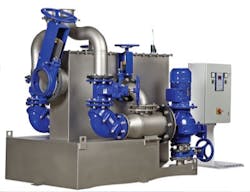When engineers and review authorities first consider subsurface water storage systems for stormwater management, they will frequently ask how the storage chambers are maintained, especially for the removal of sediment.
Underground storage systems vary in design, but in many cases it is impossible to physically enter the storage structure after installation is complete. While sedimentation can be removed from these structures with the use of dedicated maintenance ports and submersible pumps, an even better solution is to avoid allowing sediment to even enter the structure.
The sediment of greatest concern is "suspended sediment," generally defined as very fine soil particles (or other materials) that will stay in suspension even when water is moving slowly. Only when water is still (as within a storage structure) will these fine particles drop from suspension and settle to the bottom of the structure. The majority of these particles will pass a #200 screen and be classified as silt or clay sized particles.
Erosion by wind or water is the most common source of sediment materials, and is always a problem associated with construction sites. Solutions to reduce erosion impacts during construction are numerous, and beyond the scope of this paper. Current EPA regulations address erosion as a major water quality issue and do not need to be repeated here. All effort should be made to reduce the movement of soil by wind and water during construction, period.
Pre-filtration
Most underground storage systems are constructed during the early portions of site and building construction, while much of the site will remain exposed to erosion forces. During construction, stormwater must be kept clean and free from sediment before entry into the storage structure. If this is not possible, then contractors should provide a separate, temporary detention/siltation basin and divert stormwater away from the storage structure.
At the completion of construction, permanent erosion control features (vegetation, ground cover and mulch, paving, etc.) should be in place and effective at minimizing sediment removal and transport. Long term sediment control measures may include both structural and non-structural approaches.
Structural sediment control measures include catch basin and inlet filtration, using geotextile filter bags, cyclonic water movement for deposition and control of debris and sediment (only partially effective with fine sediments), and sediment control structures (large concrete or plastic chambers allowing physical access).
Whether standard catch basins or cyclonic flow devices are used, the objective is to remove any coarse debris and sediment (sand and larger). Periodic maintenance will be required to remove trash and sediment that accumulates in the device. Frequency will depend upon the physical nature of sediments carried and allowed into the "screening" device.
Non-structural methods include vegetated slopes and swales, and bio-filtration inlets (sand filter with rapid water capture/conveyance below). Use of a simple 10-12" deep sand, or sand/gravel, filter pavement or swale will provide adequate vertical flow capacity (20 to 35+ inches per hour) and residence time to capture coarse debris and trash at the surface, with sediment and hydrocarbons (and even most traffic generated metals) kept in voids of the section for treatment action by bacteria and oxidation.
These techniques allow stormwater to be pre-filtered before entering the storage chambers. Maintenance (periodic removal of sediment captured) is kept to ground surfaces or easily accessible inlet structures.
Allow Sediment In
If sources of fine sediment can be identified and quantities generated can be estimated fairly accurately, then it is possible to allow suspended sediment laden stormwater to enter the storage structure. Thus, sediment volume can be controlled and either stored, or removed following capture.
Sediment Storage – if the volume of suspended sediment is anticipated to be quite small (relative to the overall storage volume), then plan for the additional storage volume of sediment in water storage calculations. If the underground storage sits directly upon gravel, or a fabric layer above sand or gravel, the fine sediment material will pass through properly sized fabric and eventually fill the voids of gravel or sand layers below. The depth of the gravel or sand can be adjusted to occupy all or a majority of the historical sediment volume anticipated. Storage can also be accommodated within the storage structure itself by placing a controlled outlet pipe at a raised elevation off the floor of the structure.
Sediment Removal – if a more pro-active sediment control is desired, then placement of maintenance tubes, accessed from removable covers at the surface, will allow periodic flushing and/or pump removal of suspended sediments. Moving water will quickly put fine sediment back into suspension for removal by pump and/or outlet pipe (depending upon chamber size and geometry). Depending upon the source of sediment, possible hazardous contaminants (hydrocarbons, heavy metals, etc.) may require treatment or careful disposition of the sediment materials.
Conclusions
Sedimentation is basically an erosion control issue. First choice is to keep erosion from taking place. The second choice – if erosion cannot be stopped, then control it by best means possible, keeping area of impact as small as possible. Control stormwater speed (increase Time of Concentration), keeping speed as low as possible to minimize sediment particle size and volume. You can do this by providing rough surfaces, a circuitous path and shallow gradients
Use natural methods whenever possible to slow and filter stormwater before entering open drainages, creeks, rivers and oceans. Porous paving, Bio-slopes, Bio-swales, Bio-filters, and sand filters can all be used to remove sediments.
About the Author: Kate Wright has been the Staff Engineer at Invisible Structures Inc. since 2003. She has extensive knowledge of stormwater management systems and is a LEED™ AP.
More WaterWorld Current Issue Articles
More WaterWorld Archives Issue Articles




